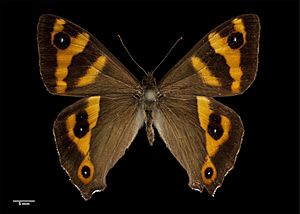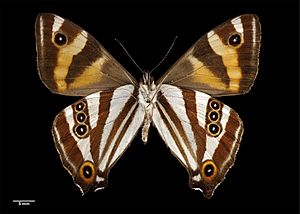Forest ringlet facts for kids
Quick facts for kids Forest ringlet |
|
|---|---|
 |
|
| Upperside | |
 |
|
| Underside | |
| Scientific classification | |
| Synonyms | |
|
[Dodonidia] helmsi Fereday, 1883 |
The forest ringlet (Dodonidia helmsii) is a special and rare butterfly. It is also known as Helms' butterfly. This unique butterfly lives only in New Zealand. It is the only species in its group, called Dodonidia.
How the Forest Ringlet Got Its Name
The forest ringlet was first found by a scientist named Richard William Fereday. He found a specimen collected by Mr. R. Helms. Mr. Helms found it in the Paparoa Range. Fereday gave it the name helmsi.
Later, in 1884, another scientist, Arthur Gardiner Butler, officially named the butterfly. He created the group name Dodonidia. This name came from its similarity to some Asian butterflies called Dodona. Butler also corrected the spelling of the species name to D. helmsii. Because it was named after Mr. Helms, it is sometimes called "Helms' butterfly". However, "forest ringlet" is the name most people use.
Forest Ringlet Life Cycle and Habitat
The forest ringlet caterpillar is active at night. It eats certain types of grass, like "cutty grass" (Gahnia) and bush snowgrass (Chionochloa). Caterpillars feed from spring until early autumn.
Adult butterflies live for about three or four weeks. They are very fast flyers. You can usually see them in January and February. They like to fly in clearings or near the edges of forests. They are mostly found in beech (Nothofagus) forests. These forests are usually north of places like Lewis Pass.
Why the Forest Ringlet Needs Our Help
The forest ringlet butterfly used to be found all over New Zealand. This included areas like Wellington and Auckland. But over the last 50 years, it has become much rarer. There are two main reasons for this.
First, the special grasses that the caterpillars eat are becoming harder to find. This is especially true in lower areas. Second, new types of wasps have come to New Zealand. These wasps hunt and eat the butterfly's young, called larvae.
Forest ringlets have disappeared from forests below 400 meters (about 1,300 feet) high. But they can still be found at 600 meters (about 2,000 feet) or higher. This is because the German and common wasps usually do not go that high. Because of these threats, the forest ringlet is now considered "At Risk, Relict" in New Zealand. This means it is a species that needs protection.

